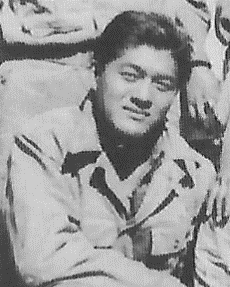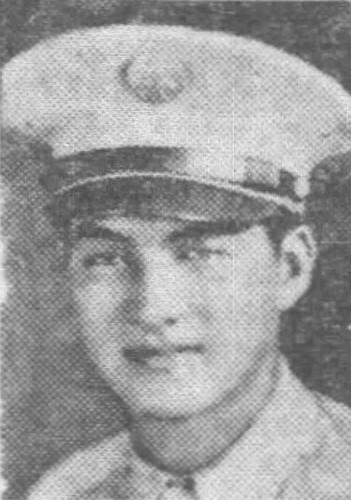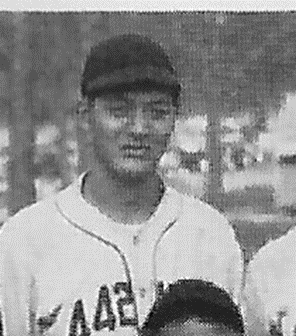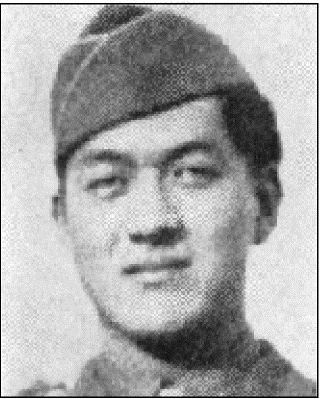
Fred Yoshito Kameda
Private First Class
442nd Regimental Combat Team
3rd Battalion, I Company
Fred Yoshito Kameda was born on May 5, 1923, in Waialua, Oahu, Territory of Hawaii. He was one of eight sons of Genzo and Kazu (Tsukada) Kameda. His brothers were: Satoru, Tadashi, Mitsuo, Shigeo, Toshio, Akio, and Kazumi.
Genzo and Kazu arrived from Yamaguchi Prefecture, Japan, in 1899 and 1906, respectively. Genzo worked for Waialua Agriculture Company. He started as a field worker on the sugar plantation. By 1940, he worked in the machine shop and Kazu was a housekeeper in the Plantation Club House.
Fred was educated at Waialua Elementary School and graduated from Mid-Pacific Institute in Honolulu in 1941. While at Mid-Pac, he was active in the Drama Club. He and his brothers were well-known baseball players in the pre-war years. Fred was a pitcher on the Mid-Pacific baseball team.
Kameda registered for the draft on June 30, 1942, at Local Board No. 11, Waialua Fire Station, in Waialua. At the time, he was living with his family in House 68, Mill 13 in Waialua and employed as a truck helper or “engine tender” by the Waialua Agriculture Company (sugar mill). He was 5’8” tall and weighed 152 lbs. He listed Tom Kameda, an older brother of Poamoho Camp in Wahiawa, as his point of contact.

Fred Yoshito Kameda enlisted in the U.S. Army at Schofield Barracks on Oahu on March 23, 1943. His civilian occupation was listed as “accountants/auditors.” He was a clerk at Territorial Motors Ltd. in Honolulu. He was sent with other inductees to the “tent city” known as Boom Town at Schofield Barracks. On March 28, they were given a community farewell at Iolani Palace. On April 4, they sailed on the S.S. Lurline to San Francisco. After a train trip across the US, they arrived at Camp Shelby, Mississippi, for training. After basic training, Fred was assigned to 3rd Battalion, I Company, of the 442nd Regimental Combat Team (RCT).
After over a year of training, Fred shipped out to Europe with the 442nd on May 2, 1944, from Hampton Roads, Virginia, in a convoy of over 100 ships. A friend, Harold Watase, who bunked across the narrow aisle from Fred on the Liberty ship James Turner, later recalled that Fred had his ukulele with him and entertained everyone with his great tenor voice and renditions of such songs as Bésame Mucho. He said that Fred was the sort of man who would fetch food or whatever for the soldiers who were seasick on the crossing.
On 28 May they arrived at Naples, Italy, and spent a week at a staging area in nearby Bagnoli preparing to enter the combat zone. The RCT then boarded LSTs and sailed to the Anzio beachhead, landing on June 6. From the beach they marched 5 miles to a bivouac area to prepare for convoy by truck farther north.

From Anzio, the 442nd went to a large bivouac area near Civitavecchia, north of Rome, where they went through additional training and final preparations for going to the front lines. While there, Fred reunited with some old buddies – Toshio Nakahara of L Company, Larry “Cupie” Shigeyasu and Mitsuru Watanabe of 100th Battalion, B Company, and “Eggs” Kamikawa. They had played on the 442nd baseball team at Camp Shelby. They “spent the whole day just talking of old times and of what we’ll soon see….We’ll do our best,” as Nakahara later wrote.
Left: Fred was a great pitcher on the 442nd’s baseball team, which won two divisional championships at Camp Shelby.
On June 26, 1944, the 442nd RCT moved forward from Civitavecchia to the front lines for their first combat engagement. The units were in place pre-dawn; I Company pushed off at 9:00 a.m. Two hours later they were stopped by fierce resistance from the Germans, unable to advance beyond Suvereto. Pfc. Fred Yoshito Kameda died of wounds received during this first engagement.

Pfc. Kameda was interred at the U.S. Army Cemetery at Tarquinia, Italy. His family held a memorial service for him on July 30, 1944, at the Waialua Hongwanji Mission.
Right: Fred Kameda, 2nd Platoon, Camp Shelby
According to Captain Sadaichi Kubota, 2nd Platoon: “There was everything positive about Fred…good-looking, gregarious, outstanding athlete…great member of 3rd Squad, 2nd Platoon… He was diligent in learning the rudiments of a combat soldier and adopted the BAR, Browning Automatic Rifle, as his closest ‘friend’…he qualified as an Expert.” A close friend, Kiichi Sonoda, described him as very kind and compassionate with a fun-loving nature. During Camp Shelby days, Kiichi and Fred used to visit internment camps at Jerome and Rohwer, Arkansas, to see and comfort friends from Hawaii.
Fred was among the first in the 3rd Battalion to be killed in action. Kiichi relates the story as follows: “After overrunning Belvedere, the 3rd Squad was assigned as the lead element to advance into enemy territory. As they cautiously walked, a shot rang out. Kiichi looked to the rear and saw Fred lying on the ground. He quickly went to his aid. Searching for the wound, he found that Fred had been shot at a vital spot of his body. Fred expired soon thereafter….Fred, an expert rifleman and model soldier, died without firing a single shot at the enemy…Kiichi replaced him as a BAR man.”
For his military service, Private First Class Fred Yoshito Kameda was awarded the Bronze Star Medal, Purple Heart Medal, Good Conduct Medal, American Campaign Medal, European-African-Middle Eastern Campaign Medal with one bronze star, World War II Victory Medal, and Combat Infantryman Badge. He was awarded the Congressional Gold Medal on October 5, 2010, along with the other veterans of the 100th/442nd Regimental Combat Team. This is the highest Congressional Civilian Medal.
On December 9, 1945, a memorial service for 266 war dead of the 100th/442nd, including Kameda, was held at McKinley High School auditorium in Honolulu. The service was sponsored by the 100th Battalion and the 442nd veterans, the Women’s War Service Committee, and the Emergency Service Committee. Lt. General Robert C. Richardson gave the main address.

In 1948, the remains of Americans buried overseas began slowly to return to the U.S., if the family so wished. As a result, on April 21, 1949, Pfc. Fred Y. Kameda arrived home. The USAT Sergeant Jack J. Pendleton brought back 134 men, arriving at Honolulu Harbor’s Kapalama Basin. There were hundreds of family and friends present to attend the dockside service. The Secretary of Hawaii, Oren E. Long, officiated, the 264th Army Band played, and military Chaplains participated. The caskets were stored in the Army mausoleum at Schofield Barracks on Oahu pending funeral arrangements.
On May 30, 1949, Kameda was one of sixteen fallen soldiers from Waialua and Kahuku who were memorialized at a service held at the Memorial Tower in Waialua Park. The service was sponsored by the Waialua Lions Club, 100th and 442nd Veterans Clubs, Waialua National Guard, and local post of the American Legion.
Private First Class Fred Yoshito Kameda was interred on July 28, 1949, at the National Memorial Cemetery of the Pacific at Punchbowl in Honolulu, Section D, Site 366. On August 2 his family published a Card of Thanks in the newspaper expressing their gratitude for all the kindnesses and floral offerings they had received. His government gravestone was ordered from West Chelmsford, Massachusetts, on January 13, 1950.
His brother Akio Donald Kameda also served in the 442nd in I Company. Brother Kazumi Robert Kameda served in Military Intelligence during World War II.
Prior to the December 7, 1941, attack on Pearl Harbor, a third brother, Shigeo Kameda, was drafted into the Japanese Imperial Navy where he served as a submarine officer.
Researched and written by the Sons & Daughters of the 442nd Regimental Combat in June 2021. Updated in October 2021.
